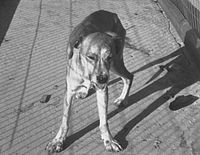
Photo from wikipedia
Abstract Background Reverse zoonoses occur because of interactions between humans and animals. Homology of ACE‐2 cell receptors in different hosts and high mutation rate of SARS‐CoV‐2 enhance viral transmission among… Click to show full abstract
Abstract Background Reverse zoonoses occur because of interactions between humans and animals. Homology of ACE‐2 cell receptors in different hosts and high mutation rate of SARS‐CoV‐2 enhance viral transmission among species. Objectives This study aimed to investigate spillover of SARS‐CoV‐2 between humans and companion animals. Methods A cross‐sectional study was constructed using nasopharyngeal/oropharyngeal swabs, serum and blood samples collected from 66 companion animals (33 cats and 33 dogs) that were in contact with SARS‐CoV‐2‐positive owners from December 2020 to March 2021. Swabs were screened by rRT‐PCR and some positive cases were confirmed by partial spike gene sequencing. Clinical pathology and pathological studies were also performed. Results Our findings revealed that 30% of cats (10/33) and 24% of dogs (8/33) were SARS‐CoV‐2 positive. While 33% of these animals were asymptomatic (6/18), 28% showed mild respiratory signs (5/18) and 39% displayed severe respiratory signs (7/18) including 4 dead cats 40% (4/10). Partial spike gene sequencing of 6 positive samples collected in December 2020 were identical to SARS‐CoV‐2 that was detected in humans in Egypt in that time frame. Clinical pathology findings revealed thrombocytopenia, lymphocytopenia, as well as elevated levels of D‐dimer, LDH, CRP, and ferritin. Post‐mortem and histopathological examinations illustrated multisystemic effects. Conclusions There is a potential occurrence of SARS‐CoV‐2 spillover between humans and pet animals. Impacts The present study highlighted the potential occurrence of SARS‐CoV‐2 spillover between humans and their companion animals. Biosecurity measures should be applied to decrease spread of SARS‐CoV‐2 among humans and pet animals.
Journal Title: Veterinary Medicine and Science
Year Published: 2022
Link to full text (if available)
Share on Social Media: Sign Up to like & get
recommendations!